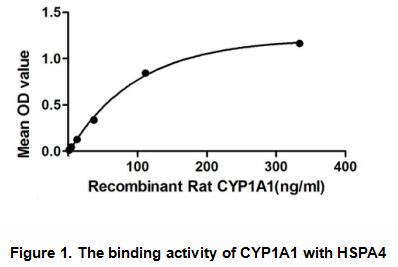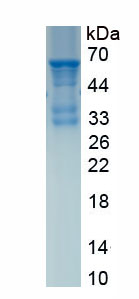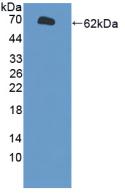Active Cytochrome P450 1A1 (CYP1A1) 

CYP1; AHH; AHRR; CP11; CYP1; P1-450; P450-C; P450DX; Cytochrome P450,Subfamily I(Aromatic Compound-Inducible),Polypeptide 1
- UOM
- FOB US$ 360.00 US$ 900.00 US$ 1,800.00 US$ 5,400.00 US$ 13,500.00
- Quantity
Overview
Properties
- Product No.APD295Ra01
- Organism SpeciesRattus norvegicus (Rat) Same name, Different species.
- ApplicationsCell culture; Activity Assays.
Research use only - DownloadInstruction Manual
- CategoryMetabolic pathway
- Buffer FormulationPBS, pH7.4, containing 0.01% SKL, 5% Trehalose.
- Traits Freeze-dried powder, Purity > 80%
- Isoelectric Point6.8
Sign into your account
Share a new citation as an author
Upload your experimental result
Review

Contact us
Please fill in the blank.
Activity test

Cytochrome P450 1A1 (CYP1A1) is a member of Cytochromes P450 superfamily of enzymes. Cytochromes P450 are a group of heme-thiolate monooxygenases. It oxidizes a variety of structurally unrelated compounds, including steroids, fatty acids, and xenobiotics. CYP1A1 is also known as AHH (aryl hydrocarbon hydroxylase). It is involved in the metabolic activation of aromatic hydrocarbons (polycyclic aromatic hydrocarbons, PAH). Besides, Heat Shock 70kDa Protein 4 (HSPA4) has been identified as an interactor of CYP1A1, thus a binding ELISA assay was conducted to detect the interaction of recombinant rat CYP1A1 and recombinant rat HSPA4. Briefly, CYP1A1 were diluted serially in PBS, with 0.01% BSA (pH 7.4). Duplicate samples of 100uL were then transferred to HSPA4-coated microtiter wells and incubated for 2h at 37℃. Wells were washed with PBST and incubated for 1h with anti-CYP1A1 pAb, then aspirated and washed 3 times. After incubation with HRP labelled secondary antibody, wells were aspirated and washed 3 times. With the addition of substrate solution, wells were incubated 15-25 minutes at 37℃. Finally, add 50µL stop solution to the wells and read at 450nm immediately. The binding activity of of CYP1A1 and HSPA4 was shown in Figure 1, and this effect was in a dose dependent manner.
Usage
Reconstitute in 10mM PBS (pH7.4) to a concentration of 0.1-1.0 mg/mL. Do not vortex.
Storage
Avoid repeated freeze/thaw cycles. Store at 2-8°C for one month. Aliquot and store at -80°C for 12 months.
Stability
The thermal stability is described by the loss rate. The loss rate was determined by accelerated thermal degradation test, that is, incubate the protein at 37°C for 48h, and no obvious degradation and precipitation were observed. The loss rate is less than 5% within the expiration date under appropriate storage condition.
Increment services
-
 BCA Protein Quantification Kit
BCA Protein Quantification Kit
-
 Molecular Mass Marker for Protein
Molecular Mass Marker for Protein
-
 Monoclonal Antibody Customized Service
Monoclonal Antibody Customized Service
-
 Polyclonal Antibody Customized Service
Polyclonal Antibody Customized Service
-
 Protein Activity Test Experiment Service
Protein Activity Test Experiment Service
-
 Electrophoretic Mobility Shift Assay (EMSA) Experiment Service
Electrophoretic Mobility Shift Assay (EMSA) Experiment Service
-
 Buffer
Buffer
-
 Lentivirus Packaging Experiment Service
Lentivirus Packaging Experiment Service
-
 Adenovirus Packaging Experiment Service
Adenovirus Packaging Experiment Service
-
 Real Time PCR Experimental Service
Real Time PCR Experimental Service
-
 Spike RBD Protein (S-RBD)
Spike RBD Protein (S-RBD)
-
 Protein G
Protein G
-
 Protein A
Protein A
Citations
- Apiaceous Vegetable Consumption Decreases PhIP-Induced DNA Adducts and Increases Methylated PhIP Metabolites in the Urine Metabolome in RatsPubmed:25733458
- Apiaceous Vegetable Consumption Decreases PhIP-Induced DNA Adducts and Increases Methylated PhIP Metabolites in the Urine Metabolome in Rats1,2,3PubMed: 25733458
- Phenethyl isothiocyanate and indole-3-carbinol from cruciferous vegetables, but not furanocoumarins from apiaceous vegetables, reduced PhIP-induced DNA adducts in Wistar ratsPubmed:27133590
- Caspase-3, Bcl-2, p53, CYP1A1 and COX -2 as a potential target in chemoprevention of Benzo (a) pyrene-induced lung carcinogenesis in mice: Role of thymoquinoneportal:uploads
- Chemopreventive Role of Curcumin in benzo(A)pyrene induced Lung Carcinogenesis in mice via-modulation of Bcl-2, p53, Caspase-3, Cyp1A1, COX-2 and antioxidant defense system in Lung tissuesportal:uploads
- Phenethyl isothiocyanate and indole-3-carbinol from cruciferous vegetables, but not furanocoumarins from apiaceous vegetables, reduced PhIP-induced DNA adducts in Wistar rats.pubmed:27133590
- Cytochrome P450 1A1 (CYP1A1) Catalyzes Lipid Peroxidation of Oleic Acid-Induced HepG2 CellsPubmed:29738693








